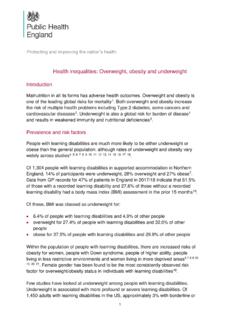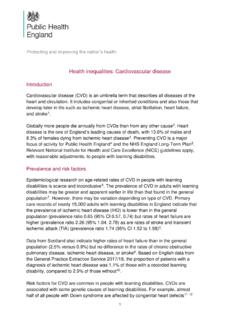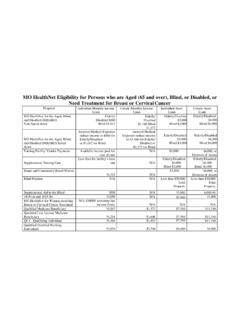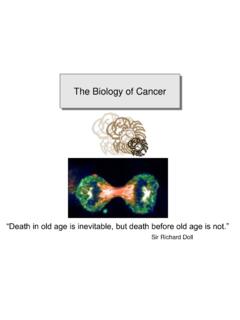Transcription of Health Inequalities: Cancer - Health Protection Agency
1 Health inequalities : Cancer Introduction Cancer is the second leading cause of death globally1. In the UK there were 359,960. new cases of Cancer in 2015 and 163,444 deaths from Cancer in 2016 which accounted for 28% of all deaths2. Prevalence and risk factors The incidence and pattern of Cancer amongst people with learning disabilities is rapidly changing partly due to increased life expectancy3 4 5 6, as the incidence of Cancer rises dramatically with age1. Epidemiological studies from other countries suggest that the incidence of Cancer among people with learning disabilities is comparable with that in the general population 7 8. Data from GP records for 47% of people in England in 2017/18 indicate that the number of patients with a recorded learning disability who had a diagnosis of Cancer was , compared to of other people9. However, mortality rates from Cancer among people with learning disabilities in England have been found not to differ from those in the general population10 11.
2 It would not be meaningful to propose a tumour profile for the entire heterogeneous population of people with learning disabilities12. However, studies that specify types of Cancer deaths indicate that most underlying causes of Cancer deaths for people with learning disabilities are from diseases of the digestive organs13. This differs from the pattern of cancers found in the general population, in whom lung, breast and prostate Cancer predominate. Oral tumours in patients with learning disabilities may be less frequent than in the general population14. The prevalence of cervical Cancer is lower in women with learning disabilities than other women7 8 15. Men with learning disabilities may be more likely to develop testicular Cancer than other men16 17. Down syndrome is undoubtedly associated with increased risk of testicular cancer17. The incidence of acute leukaemia is elevated among people with Down syndrome, whereas solid tumours are uncommon18.
3 People with fragile X syndrome may be at lower risk of some types of cancer19. 1. Health inequalities : Cancer Around one-third of deaths from Cancer are due to the 5 leading behavioural and dietary risks: high body mass index low fruit and vegetable intake lack of physical activity tobacco use alcohol use1. People with learning disabilities are less likely to smoke or drink alcohol, but are more likely to be overweight or obese, to have poor diet and to do insufficient physical activity compared to the general population20. The risk for lung Cancer in people with learning disabilities strongly correlates with the severity of learning disabilities, with smoking being more common among those with mild learning disabilities21. There is a high prevalence of Helicobacter pylori in people with learning disabilities, a class 1 carcinogen linked to stomach Cancer , gastric ulcer and lymphoma among people with learning disabilities22 23 24.
4 It has also been hypothesized that digestive system cancers may be influenced by gastrointestinal tract dysfunction, gastro- oesophageal reflux disease, chronic constipation and poor diet 6. These Health risks are common in people with learning disabilities. Impact on people with learning disabilities Cancer is a leading underlying cause of death among people with learning disabilities13. Neoplasms have been found to be the third most common cause of death of people with learning disabilities in England11. For people with learning disabilities, tumours are more often diagnosed at a late stage14 17. The way that people with learning disabilities express pain and distress is highly individual25. People with learning disabilities might not express pain or report changes in their physical appearance which can lead to substantial delays in symptom presentation and diagnosis26.
5 Residential care staff may lack knowledge of the signs and symptoms of Cancer , as well as the risk factors for certain cancers27. Recent analysis of NHS Hospital Episode Statistics suggests that people with learning disabilities are far more likely to die from testicular Cancer than the general population, with a one in 10 chance of dying from the Cancer , as opposed to a one in 36 chance in the general population16. Analysis of data regarding other types of Cancer (for example prostate, breast and colorectal Cancer ) is ongoing16. 2. Health inequalities : Cancer Healthcare and treatment Cancer mortality can be reduced if cases are detected and treated early1. People with learning disabilities in the UK are significantly less likely to receive NHS. screening tests for cervical , bowel and breast Cancer than those without learning disabilities28. At a national level, reported Cancer screening coverage for eligible people with learning disabilities in 2012/13 was substantially lower than for the population as a whole ( cervical Cancer screening of people with learning disabilities vs 70% of total population; breast Cancer screening vs.)
6 Bowel Cancer screening vs )29. The Confidential Inquiry into premature deaths of people with learning disabilities (CIPOLD) reported that the greatest difficulties for people with learning disabilities appeared to be with access to bowel Cancer screening30. More recent 2017/18 data from approximately half of GP practices in England report the following rates of Cancer screening in the last 5 years ( cervical Cancer screening of people with learning disabilities vs of population without learning disabilities; breast Cancer screening vs ; bowel Cancer screening vs )9. There is some anecdotal evidence that screening liaison nurses could improve participation in Cancer screening31. There is little research regarding the treatment of people with learning disabilities who have Cancer . Caregivers may feel uncomfortable and unprepared to support the patient, and attempt to protect the patient from negative effects of Cancer by limiting truth-telling26.
7 Oncology nurses may perceive themselves as lacking confidence and being insufficiently trained to recognise and meet the needs of Cancer patients with learning disabilities32. There is a need to develop effective ways of supporting Health care professionals in enhancing patient-centred skills with this population26. Social determinants The incidence and mortality of Cancer is considerably higher in deprived groups compared with more affluent groups33. This has been attributed to environment, lifestyle, biological effects, access to Health care and Health seeking behaviour34. However, there is no known data specifically relating to people with learning disabilities. The quality of social care support received and access to appropriate healthcare is likely to impact on the prevention and early diagnosis of Cancer in people with learning disabilities but there is no known research that has specifically addressed this issue.
8 3. Health inequalities : Cancer Resources Public Health England (2018) Reasonable adjustments for people with a learning disability: Cancer Screening References 1 World Health Organization (2018) Cancer : Key Facts 2 Cancer Research UK Cancer Statistics for the UK. 3 Jancar J. Cancer and mental handicap: a further study. British Journal of Psychiatry, 1990. 156: p. 531-533. 4 Duff M and others. Helicobacter pylori: has the killer escaped from the institution? A. possible cause of increased stomach Cancer in a population with intellectual disability. Journal of Intellectual Disability Research, 2001. 45: p. 219-225. 5 Bonell S. Neoplasms, in Intellectual disability and ill Health : a review of the evidence, J. O'Hara, JE McCarthy, and N Bouras, Editors. 2010, Cambridge University Press: Cambridge. p. 127-136. 6 Cooke LB. Cancer and learning disability. Journal of Intellectual Disability Research, 1997.
9 41(4): p. 312-316. 7 Patja K, Eero P, and Iivanainen M. Cancer incidence among people with intellectual disability. J Intellect Disabil Res, 2001. 45(Pt 4): p. 300-7. 8 Sullivan SG and others. The incidence of Cancer in people with intellectual disabilities. Cancer Causes Control, 2004. 15(10): p. 1021-5. 9 NHS Digital (2019) Health and Care of People with Learning Disabilities: Experimental Statistics: 2017 to 2018]. 10 Tyrer F and McGrother C. Cause-specific mortality and death certificate reporting in adults with moderate to profound intellectual disability. Journal of Intellectual Disability Research, 2009. 53(11): p. 898-904. 11 Glover G and others. Mortality in people with intellectual disabilities in England. Journal of Intellectual Disability Research, 2017. 61(1): p. 62-74. 12 Hogg J and Tuffrey-Wijne I. Cancer and Intellectual Disability: A Review of Some Key Contextual Issues.
10 Journal of Applied Research in Intellectual Disabilities, 2008. 21(6): p. 509-518. 13 O'Leary L, Cooper S-A and Hughes-McCormack L. Early death and causes of death of people with intellectual disabilities: A systematic review. Journal of Applied Research in Intellectual Disabilities, 2018. 31(3): p. 325-342. 14 Satg D and others. A mucoepidermoid carcinoma in a young man with intellectual disability: review of oral Cancer in people with intellectual disability. Oral Surgery, Oral Medicine, Oral Pathology and Oral Radiology, 2013. 115(5): p. e22-e27. 15 Parish SL and others. Reproductive Cancer Treatment Hospitalizations of Women with Intellectual and Developmental Disabilities. Intellectual and Developmental Disabilities, 2018. 56(1): p. 1-12. 16 Afshar M and others. 1085 - Testicular Cancer in patients with learning disabilities in England from 2001-2015: A national cohort study.










